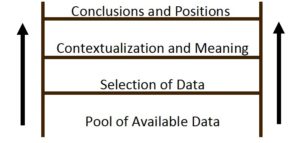June 1, 2017
By Vincent Lowney
Imagine a negotiation over buying a used car. Both the salesperson and the customer are looking at the same car in the same lot. However, each person has reached different conclusions about the suitability of the car for the customer. The salesperson is certain this car is perfect, while the customer can’t wait to move on to something else.
How can two people, receiving the same data at the same time, come to such different conclusions? By better understanding the process of how we reach conclusions, we can improve our negotiation skills and more effectively influence others. First described by organizational psychologist Chris Argyris and later popularized by Peter Senge in his book The Fifth Discipline, the Ladder of Inference demonstrates how we go from shared information to a variety of conclusions and positions.

We are standing in a pool of data at all times, comprised of everything from the smell of your morning coffee to the book you are reading. Because we have a limited amount of processing power at any given time, our brains make a decision as to what is worth focusing on. For example, can you feel your socks right now? Before I mentioned it, I imagine not! That is an example of the data we have available, but we don’t process.
Back to our negotiation over the used car. The salesperson has a variety of brochures available regarding the safety features of the vehicle, but the customer recently read a scathing review online. The car salesperson, with the best of intentions, is trying to persuade the customer to buy the car. Without knowing what’s most important to the customer, though, the salesman is focused on what’s most persuasive to him.
Once a person has selected the information and processed it, they then place it within the context of their experiences. People assign meaning to this raw data. We see the salesperson, having sold a variety of cars with different safety ratings, believing that this car is safer than the average sedan. However, the customer is comparing the same safety rating with their current vehicle and so views the new car as being a more dangerous option. Both have the same basic information but are framing it differently.
The final step of the ladder is to reach a conclusion or position. Based on the selected information, bolstered by the context within which it was placed, we formulate our ideas. The salesperson is convinced this is a safe, efficient vehicle perfect for their customer, while the potential buyer sees a deathtrap. What we often do at this stage is merely present our conclusion – “Look at how safe it is!” versus “Look at how ugly it is!”. This top of the ladder jousting is as frequent as it is inefficient.
When we think of the typical salesperson, we can imagine them listing all the highlights of the product they are selling: how many miles per gallon the car gets, or how the stereo can “go to eleven”. These statements are a type of advocacy – making the case for why this position should be accepted by the other side.
But, to truly make the case, we must first understand where the other party is coming from. To improve your negotiation skills, start with inquiry – using questions to understand the context and framing that the other party brings to the table. Ask questions to understand why and how they have reached their conclusions. Some useful questions are “What in your experience leads you to believe this?” (addressing their context) or “what have you seen that brings you to this conclusion? (addressing their selection of data).
After walking down the other person’s ladder of inference and better understanding the data and context that led to their conclusion, transition your negotiation skills to advocacy. Presenting your ladder of thinking and building your argument from the shared data allows you to have a more connected negotiation and reach shared conclusions. This negotiation skill is called having a “U-shaped” conversation.
The ladder of inference is a complementary concept that allows us to appreciate the process people go through as they process information and create the conclusions about the content of our negotiation. By understanding how people develop positions and, we can more effectively persuade them with other arguments.
Improve Your Negotiation Skills
To learn about building your team’s negotiation skills using the Ladder of Inference and other tools, contact Chuck Doran at 617-895-4026 or cdoran@mwi.org.